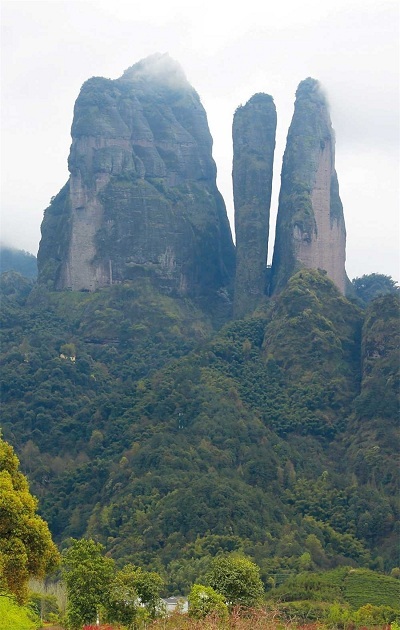Unearthing the history and natural beauty of an ancient city
 0 Comment(s)
0 Comment(s) Print
Print E-mail Shanghai Daily, October 11, 2017
E-mail Shanghai Daily, October 11, 2017
|
Jianglang Mountain in Quzhou has three peaks that form the shape of a "W." (Wang Rongjiang) |
Quzhou is a place that has lots to offer travelers who love to unearth the historical, cultural and social structures of an ancient city.
At the west end of Zhejiang Province, the scenery of Quzhou is quite different from that of the rest of the area.
Geographically, the city has a unique, steep landform that can't be found elsewhere, thus providing essential tourist resources.
Located on the boundary of Zhejiang, Fujian, Jiangxi and Anhui provinces, Quzhou has been a significant hub of transport for more than 1,800 years. People from both the north and south gathered here, bringing cultures from all over the country.
The term "Danxia landform" may not sound familiar to many people, as it is only found in southeast, southwest and northwest China. The landform, according to World Heritage Center of UNESCO, "consists of a red bed characterized by steep cliffs."
Danxia landform looks quite like karst topography, but as the Danxia rocks are sandstones and conglomerates, unlike karst which is formed by limestones, Danxia is also called "pseudo-karst" landform.
Jianglang Mountain in Quzhou is of typical Danxia landform. The most recognizable landmarks of the mountain are three peaks from north to south. It was inscribed onto the World Heritage List in August 2010.
The three peaks form the shape of a "W," and people could walk on the underside of the peaks. As the steeps are very close to each other, visitors can see above them a very thin slit of sky. Such a "slit of sky" can be found in many Chinese mountains, but this one here is said to be the longest in the country.
Climbing the mountain is no easy task. As the peaks are almost straight up and down, from time to time people need to use both hands and feet to go up.
"Many people gave up halfway," said Liang Guan, a tourist. "But you need to know that the best scenery is always waiting for those who stick out to the end. I saw how the clouds shrouded around the peaks, and the scenery will stay with me for a long time."
It is widely known that the hometown of Confucius is Qufu, Shandong Province, but not many people know that the master had a family temple in Quzhou, which is usually called the "Southern Clan."
The temple, now on Xinqiao Street, is one of the only two family temples of Confucius. Built by Kong Duanyou (1078-1132), a descendant of Confucius, the temple was the result of a war during the later years of the Northern Song Dynasty (960-1127).






